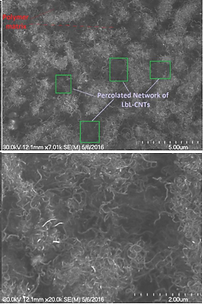Regenerative Biomaterials
Current research programmes focuse on multi-functional bio-mimetic materials for musculoskeletal and neural tissue regeneration. In particular, this research theme exploits the development of 3D bioactive and biodegradable elastomeric scaffolds to modulate regenerative processes. Other interests in this research theme include the development of polymeric nanocomposites with enhanced physicomechanical, bioactive and electrochemical properties as next-generation biomaterials and components of medical devices.
Ongoing Projects
Bioactive citric acid composite soft-tissue anchors
The Biggs lab, with CURAM and in collaboration with Acuitive Technologies, New Jersey, will investigate the formulation and fabrication of a regenerative bone-ligament anchor through functional citrate materials, utilising HA and β-TCP to formulate bioactive biodegradable nanocomposite materials. Specifically the project will focus on assessing the efficacy of such in promoting regeneration, providing insight into the mechanisms of citrate polymer composite mediated regeneration at the bone-ligament interface. The project will investigate the formulation, fabrication, surface chemistry, stability, biocompatibility, polymer degradation and the effects of degraded polymer and its residues on MSC viability, inflammatory and metabolic pathways. The project will also investigate the cellular and biochemical pathways involved in osteogenic differentiation of MSCs in the presence of citric acid composites using high-throughput microarray analysis.

Funding:
SFI
Actuitive Technologies
The Biggs lab, with CURAM and in collaboration with Acuitive Technologies, New Jersey, will investigate the formulation and fabrication of a regenerative bone-ligament anchor through functional citrate materials, utilising HA and β-TCP to formulate bioactive biodegradable nanocomposite materials. Specifically the project will focus on assessing the efficacy of such in promoting regeneration, providing insight into the mechanisms of citrate polymer composite mediated regeneration at the bone-ligament interface. The project will investigate the formulation, fabrication, surface chemistry, stability, biocompatibility, polymer degradation and the effects of degraded polymer and its residues on MSC viability, inflammatory and metabolic pathways. The project will also investigate the cellular and biochemical pathways involved in osteogenic differentiation of MSCs in the presence of citric acid composites using high-throughput microarray analysis.
Bioactive Poly(glycerol sebacate urethane) Composites as Bioresorable Neural Interface Materials
We are developing a library of conducting nanocomposites biomaterials employing Poly(glycerol sebacate urethane) - a cytocompatible and bio-resorbible elastomer. Ongoing studies are investigating the efficacy of these materials as electrically conducting neural interfaces and regenerative conduit materials for spinal cord repair. Further innovations with these materials will be realised through neuromorphic formulation to render the materials morphologically neuron-like. The project will investigate the formulation, fabrication, surface chemistry, stability, biocompatibility, polymer degradation and the effects of the degraded polymer and its residues on the viability, inflammatory and metabolic pathways in neural cell populations. The project will also investigate two-photon lithography approaches for the fabrication of neuromprphic scaffolds presenting submicron and nanoscale complexity.


Funding:
SFI
Injectable Nanocellulose Hydrogels for Intervertebral Disk Regeneration
successful tissue-engineering approaches to IVD regeneration rely on an ability to provide immediate closure of the defect. Additionally, the 3D matrix should mechanically support the region while promoting integration within surrounding tissues, support cell proliferation and ECM deposition initiating the regenerative process. The intrinsic non-covalent self-gelling hydrogels, such as methacrylated gellan-gum (GGMA), are versatile materials with injectable capability. The simple and cost-effective fabrication process along with the impressive mechanical properties of GG-based constructs makes them an excellent biomaterial to be exploited. GGMA-based hydrogels have been widely studied as tissue substitutes. Additionally, GG hydrogels offer potential in the development of composite systems through reinforcement with nanoparticle fillers. In the Biggs lab, a GGMA hydrogel reinforced with cellulose nanocrystals (nCell) is being investigated in vitro as an annulus fibrosis substitute.

People:
Diana Pereira
Funding:
SFI
Two-Photon Lithography Cross- Linked Hydrogels for Spinal Cord Regeneration
One key area of focus in the Biggs lab is the use of bio-inspired design to guide the fabrication of biomaterial scaffolds for tissue engineering applications. Using modern additive manufacturing techniques, three-dimensional structure can be fabricated with structural and mechanical characteristics that mimic that of the nervous system. Such approaches can be used to guide the directional growth of cells via geometrical and topographical structural guidance. Current efforts are focused on synthesising photosensitive hyaluronic acid and collagen formulations for two-photon patterning.

Funding:
SFI
NUI Galway Hardiman Scholarship


